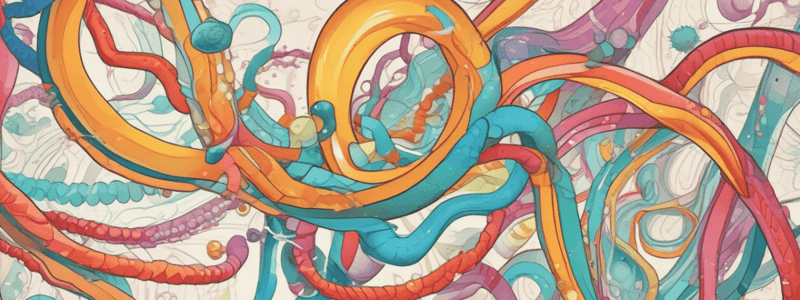Podcast
Questions and Answers
In which condition does saliva excrete glucose?
In which condition does saliva excrete glucose?
- Hyperparathyroidism
- Hyperthermia
- Nephritis
- Diabetes mellitus (correct)
What helps in loss of heat and regulation of body temperature in dogs and cattle?
What helps in loss of heat and regulation of body temperature in dogs and cattle?
- Sweat glands
- Tears
- Saliva (correct)
- Urine
What happens to salivary secretion when the body water content decreases?
What happens to salivary secretion when the body water content decreases?
- It increases
- It decreases (correct)
- It remains the same
- It fluctuates
What type of nervous mechanism regulates salivary secretion?
What type of nervous mechanism regulates salivary secretion?
Which division of the autonomic nervous system supplies salivary glands?
Which division of the autonomic nervous system supplies salivary glands?
Where are the parasympathetic preganglionic fibers to submandibular and sublingual glands situated?
Where are the parasympathetic preganglionic fibers to submandibular and sublingual glands situated?
What is the final destination of the preganglionic fibers to submandibular and sublingual glands?
What is the final destination of the preganglionic fibers to submandibular and sublingual glands?
What happens to thirst when water is taken?
What happens to thirst when water is taken?
Which of the following is NOT a function of salivary amylase?
Which of the following is NOT a function of salivary amylase?
What is the primary role of lingual lipase in digestion?
What is the primary role of lingual lipase in digestion?
What is the role of lysozyme in saliva?
What is the role of lysozyme in saliva?
What substance in saliva helps protect teeth by stimulating enamel formation?
What substance in saliva helps protect teeth by stimulating enamel formation?
Which of the following enzymes is NOT involved in the breakdown of carbohydrates?
Which of the following enzymes is NOT involved in the breakdown of carbohydrates?
Which of the following substances is NOT excreted in saliva?
Which of the following substances is NOT excreted in saliva?
Which of the following is a function of saliva that directly affects speech?
Which of the following is a function of saliva that directly affects speech?
Which of the following is NOT a characteristic of saliva?
Which of the following is NOT a characteristic of saliva?
Which of the following conditions can cause temporary hyposalivation?
Which of the following conditions can cause temporary hyposalivation?
Which of the following is NOT a parasympathomimetic drug that increases salivary secretion?
Which of the following is NOT a parasympathomimetic drug that increases salivary secretion?
What is the term for the excessive secretion of saliva in pathological conditions?
What is the term for the excessive secretion of saliva in pathological conditions?
Which of the following is an example of an unconditioned reflex involving salivary secretion?
Which of the following is an example of an unconditioned reflex involving salivary secretion?
Which of the following conditions is NOT a cause of permanent hyposalivation?
Which of the following conditions is NOT a cause of permanent hyposalivation?
Which of the following substances is known to decrease salivary secretion?
Which of the following substances is known to decrease salivary secretion?
Which of the following is a physiological condition associated with hypersalivation?
Which of the following is a physiological condition associated with hypersalivation?
Which of the following statements about conditioned reflexes is TRUE?
Which of the following statements about conditioned reflexes is TRUE?
Which of the following conditions can cause Xerostomia?
Which of the following conditions can cause Xerostomia?
What is the primary reason for drooling in children during teeth eruption?
What is the primary reason for drooling in children during teeth eruption?
Which of the following conditions is NOT directly associated with drooling?
Which of the following conditions is NOT directly associated with drooling?
What is the primary symptom of Chorda Tympani Syndrome?
What is the primary symptom of Chorda Tympani Syndrome?
Which of the following is a potential cause of Xerostomia?
Which of the following is a potential cause of Xerostomia?
Why is drooling often associated with difficulty swallowing?
Why is drooling often associated with difficulty swallowing?
Which of the following conditions can be a direct consequence of Xerostomia?
Which of the following conditions can be a direct consequence of Xerostomia?
What is the primary physiological reason for drooling in children with upper respiratory tract infections?
What is the primary physiological reason for drooling in children with upper respiratory tract infections?
What type of saliva is produced when the parasympathetic fibers are stimulated?
What type of saliva is produced when the parasympathetic fibers are stimulated?
From where do the parasympathetic preganglionic fibers of the parotid gland arise?
From where do the parasympathetic preganglionic fibers of the parotid gland arise?
What neurotransmitter is primarily involved in the parasympathetic stimulation of salivary glands?
What neurotransmitter is primarily involved in the parasympathetic stimulation of salivary glands?
Which type of reflex regulates salivary secretion?
Which type of reflex regulates salivary secretion?
What effect do sympathetic fibers have on saliva secretion?
What effect do sympathetic fibers have on saliva secretion?
Where do the postganglionic fibers from the otic ganglion reach the parotid gland?
Where do the postganglionic fibers from the otic ganglion reach the parotid gland?
Which structure does the sympathetic preganglionic fibers primarily originate from?
Which structure does the sympathetic preganglionic fibers primarily originate from?
What is the primary effect of sympatho-adrenal stimulation on salivary glands?
What is the primary effect of sympatho-adrenal stimulation on salivary glands?
Flashcards are hidden until you start studying
Study Notes
Lingual Lipase
- Lingual lipase is a lipid-digesting (lipolytic) enzyme that digests milk fats (pre-emulsified fats).
- It hydrolyzes triglycerides into fatty acids and diacylglycerol.
Salivary Enzymes
- Salivary amylase:
- Secreted by all salivary glands
- Activated by acid medium
- Converts cooked starch into maltose
- Maltase:
- Secreted by major salivary glands
- Activated by acid medium
- Converts maltose into glucose
- Lingual lipase:
- Secreted by lingual glands
- Activated by acid medium
- Converts triglycerides of milk fat into fatty acids and diacylglycerol
Functions of Saliva
- Cleansing and protective functions:
- Rinses the mouth and teeth to remove food debris, shed epithelial cells, and foreign particles
- Prevents bacterial growth by removing materials that may serve as culture media
- Contains lysozyme, which kills certain bacteria
- Contains proline-rich proteins and lactoferrin, which possess antimicrobial properties and protect teeth by stimulating enamel formation
- Contains secretory immunoglobulin IgA, which has antibacterial and antiviral actions
- Contains mucin, which protects the mouth by lubricating the mucous membrane
- Role in speech:
- Moistens and lubricates soft parts of the mouth and lips to facilitate speech
- Excretory function:
- Excretes substances like mercury, potassium iodide, lead, and thiocyanate
- Excretes some viruses, such as those causing rabies and mumps
- May excrete certain substances in pathological conditions, such as glucose in diabetes mellitus
- Regulation of body temperature:
- In dogs and cattle, excessive dripping of saliva during panting helps in loss of heat and regulation of body temperature
- Regulation of water balance:
- Decreased salivary secretion causes dryness of the mouth, inducing thirst
- When water is taken, it reduces thirst and restores body water content
Regulation of Salivary Secretion
- Salivary secretion is regulated only by nervous mechanism through autonomic nervous system
- Parasympathetic fibers:
- Stimulate salivary secretion, causing a large quantity of watery saliva with less organic constituents
- Activate acinar cells and dilate blood vessels of salivary glands
- Neurotransmitter is acetylcholine
- Sympathetic fibers:
- Stimulate salivary secretion, causing less secretion of thick, rich-in-mucus saliva
- Activate acinar cells and cause vasoconstriction by secreting noradrenaline
Reflex Regulation of Salivary Secretion
- Salivary reflexes:
- Unconditioned reflex: present since birth, induces salivary secretion when any substance is placed in the mouth
- Conditioned reflex: acquired by experience, needs previous experience, and is elicited by sight, smell, hearing, or thought of food
Effect of Drugs and Chemicals on Salivary Secretion
- Substances that increase salivary secretion:
- Sympathomimetic drugs like adrenaline and ephedrine
- Parasympathomimetic drugs like acetylcholine, pilocarpine, muscarine, and physostigmine
- Histamine
- Substances that decrease salivary secretion:
- Sympathetic depressants like ergotamine and dibenamine
- Parasympathetic depressants like atropine and scopolamine
Applied Physiology
- Hyposalivation:
- Reduction in salivary secretion
- Temporary hyposalivation occurs in emotional conditions, fever, and dehydration
- Permanent hyposalivation occurs in obstruction of salivary duct, congenital absence or hypoplasia of salivary glands, and paralysis of facial nerve
- Hypersalivation:
- Excess secretion of saliva
- Physiological condition: pregnancy
- Pathological conditions: decay of tooth or neoplasm in mouth or tongue, diseases of esophagus, stomach, and intestine, neurological disorders, and some psychological and psychiatric conditions
- Other disorders:
- Xerostomia (dry mouth): due to hyposalivation or absence of salivary secretion
- Drooling: uncontrolled flow of saliva outside the mouth, often seen in children during teeth eruption, upper respiratory tract infection, or nasal allergies
- Chorda tympani syndrome: sweating while eating due to trauma or surgical procedure affecting parasympathetic nerve fibers to salivary glands
Studying That Suits You
Use AI to generate personalized quizzes and flashcards to suit your learning preferences.




